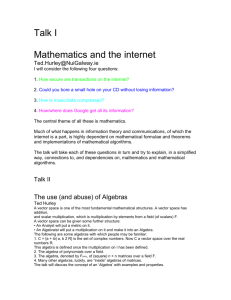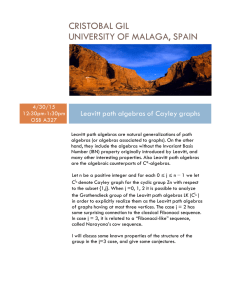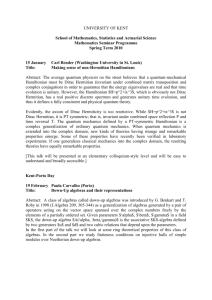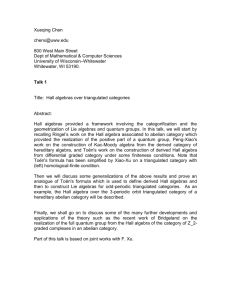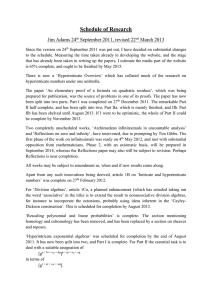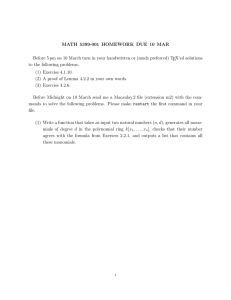A Variation of the nil-Temperley-Lieb algebras of type A Niket Gowravaram
advertisement
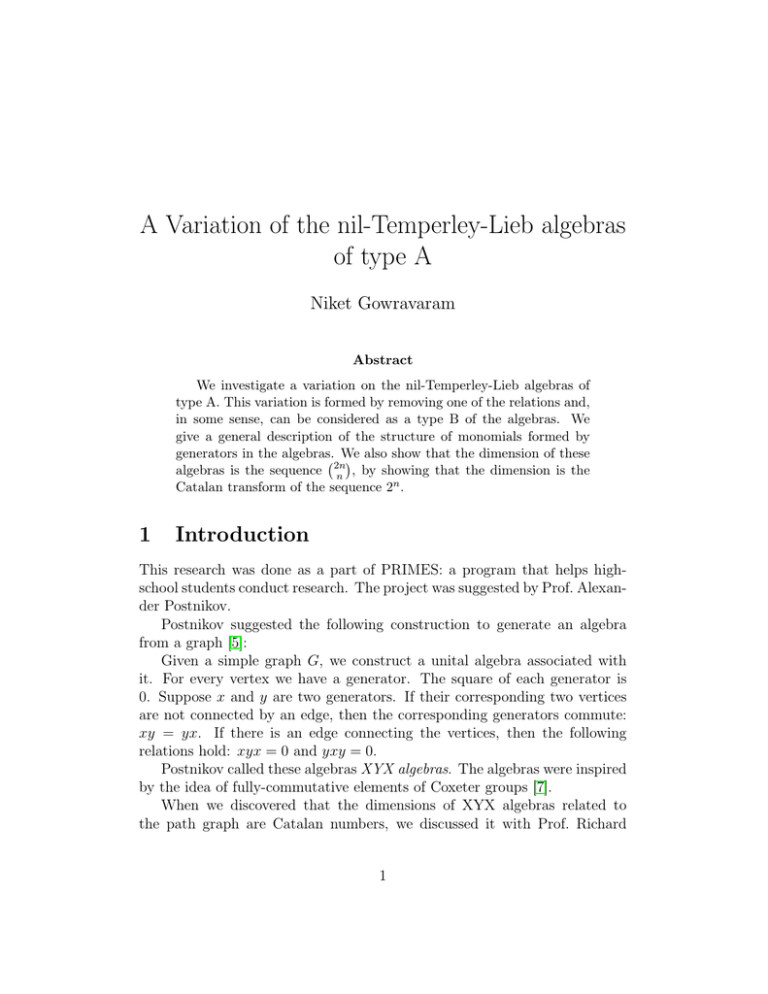
A Variation of the nil-Temperley-Lieb algebras of type A Niket Gowravaram Abstract We investigate a variation on the nil-Temperley-Lieb algebras of type A. This variation is formed by removing one of the relations and, in some sense, can be considered as a type B of the algebras. We give a general description of the structure of monomials formed by generators in the algebras. We also show that the dimension of these algebras is the sequence 2n n , by showing that the dimension is the Catalan transform of the sequence 2n . 1 Introduction This research was done as a part of PRIMES: a program that helps highschool students conduct research. The project was suggested by Prof. Alexander Postnikov. Postnikov suggested the following construction to generate an algebra from a graph [5]: Given a simple graph G, we construct a unital algebra associated with it. For every vertex we have a generator. The square of each generator is 0. Suppose x and y are two generators. If their corresponding two vertices are not connected by an edge, then the corresponding generators commute: xy = yx. If there is an edge connecting the vertices, then the following relations hold: xyx = 0 and yxy = 0. Postnikov called these algebras XYX algebras. The algebras were inspired by the idea of fully-commutative elements of Coxeter groups [7]. When we discovered that the dimensions of XYX algebras related to the path graph are Catalan numbers, we discussed it with Prof. Richard 1 Figure 1: The path graph with the first edge directed. Stanley, the author of a recent book on Catalan Numbers [6]. Richard Stanley recognized the algebras we studied as nil-Temperley-Lieb algebras. The paper [2] contains the author’s work on the nil-Temperley Lieb algebras of type A, which are the XYX algebras corresponding to the path graph. In this paper, we study a variation of the nil-Temperley-Lieb algebras of type A. More specificially, we study the XYX algebra corresponding to the path graph with the first edge directed. This algebra is generated according to the same rules, except it is based on the graph in Figure 1, where the directed edge signifies that we only have one (instead of both) of the relations xyx = 0 and yxy = 0 for the first two vertices. In this case, if x is the generator corresponding to the first vertex, and y is the second, then we are missing the relation xyx = 0, but we still have the relation yxy = 0. This graph is a natural variation of the type A case and in some sense, can be considered as a type B variation. In Section 2, we introduce our variation on the algebras and in Section 3, we describe the structure of the monomials in these new algebras. Then, in 2n Section 4, we show that the dimension of these algebras is n , by showing that the dimension is the Catalan transform of the sequence 2n . 2 The Algebras Our variation of the nil-Temperley-Lieb algebras of type A, has n generators x1 through xn that statisfy the following relations: • x2i = 0 for all i • xi xi+1 xi = 0 for 2 ≤ i ≤ n − 1 • xi+1 xi xi+1 = 0 for 1 ≤ i ≤ n − 1 2 Figure 2: The path graph with the first edge directed. • xi xj = xj xi for |i − j| > 1 Note that these relations are the exact same as the relations for nilTemperley-Lieb algebras of type A, except that these relations do not include the relation x1 x2 x1 = 0. So, this algebra could be thought of as corresponding to the path graph with a directed edge, as shown in Figure 2. We are only interested in the number of irreducible, nonequivalent monomials. So, we will only consider monomials that come first in the lexicographic ordering of their equivalent monomials. We will call such monomials u-monomials for ”unique monomials”. 3 Structure of the Monomials Lemma 1. All u-monomials for the directed edge algebra can be written as a sequence of descending runs of generators, where each subsequent element in a run is one less than its preceding element. Proof. Given an element xi , if the next element in the u-monomial is greater than it, then the next element is the start of the next descending run. If the next element is xi−1 , then it is part of the same descending run, and if the next element is less than xi−1 , then our monomial is not in lexicographic order. Thus, any u-monomial can be written as a sequence of descending runs of generators. One example is the u-monomial x1 x3 x2 x1 x6 x5 x4 , where the descending runs are x1 , x3 x2 x1 , and x6 x5 x4 . Lemma 2. The peaks of an u-monomial are strictly increasing. Proof. Suppose that a descending run has peak xi and valley xj and that the next peak is xk , where k ≤ i. We have the following cases: k ≥ j, k = j − 1, and k < j − 1. 3 • If k ≥ j, then there will be an occurrence of xk in the first run, so we will be able to form one of our zero-equivalent relations. • If k = j − 1, then xk is actually part of the first run and is not a peak. • If k < j − 1, xk commutes with xj , so our monomial is not in lexicographic order. Thus, k > i and the peaks of the u-monomial are increasing. Lemma 3. If a valley of the u-monomial is greater than 1, then the subsequent valley will be strictly greater than the previous valley. Proof. The proof of this is essentially symmetric to the previous lemma. However, it is worth noting that because we do not have the x1 x2 x1 = 0 relation, if a valley is x1 , the next valley can be x1 as well. Now we have an understanding of the structure of each of the u-monomials for the directed edge algebra and a complete way to describe them in terms of the descending runs. 4 Dimensions of the Algebras In this section, we will enumerate the dimensions of the directed edge algebras by counting the number of possible u-monomials. We shall define the function A(n, k) to be the number of u-monomials in the algebra with n generators such that the last element of the last run is xk . Note that A(n, 0) = 1, as we can include the empty monomial. Lemma 4. A(n, 1) = 2n − 1. Proof. If the last element of the last run is x1 , then we know that the last element of every run must be x1 . So, for every xi , we have two choices: either the monomial contains the run from xi to xi or the u-monomial does not contain a run starting at xi . So, we have two choices for each of n possible xi , which means that there are 2n such u-monomials. However, we must subtract one for the case that we do not have any runs (a.k.a. the empty monomial, which is equal to 1), so therefore, A(n, 1) = 2n − 1. 4 0 1 2 0 1 1 1 1 1 3 2 2 3 4 5 6 k n 3 4 5 6 1 1 1 1 7 15 31 63 6 14 30 62 6 20 50 112 20 70 182 70 252 252 Figure 3: A table of values for A(n.k) k n 0 1 2 3 4 5 0 1 1 1 1 1 1 2 4 8 16 32 1 2 6 14 30 62 3 20 50 112 70 182 4 252 5 Figure 4: A table of values for F (n.k) Figure 3 is a table with some computer calculated values of A(n, k). Now, let us define a new function F (n, k) to be the number of u-monomials in the algebra with n generators such that thePlast element of the last run is xi , where i ≤ k. In other words, F (n, k) = ki=0 A(n, i). Also, note that F (n, k) = F (n, k − 1) + A(n, k). Furthermore, note that F (n, n) is the total number of elements in the algebra with n generators and F (n, k), where k > n, will also be equal to F (n, n), because it is impossible to have an u-monomial where k > n. Figure 4 is a table with some calculated values of F (n, k). The entries that are left blank are the same as the maximum entry in their column. For example, F (3, 4) = 20. Note that F (n, 1) = 2n . This is because F (n, 1) = A(n, 0) + A(n, 1) = 1 + 2n − 1 = 2n . 5 1 1 1 2 3 5 1 4 9 14 1 5 14 28 42 1 6 20 48 90 132 Figure 5: The Catalan triangle In this table, we see an interesting pattern from the third row onwards. Each entry is the sum of the entry above it and all the entries P to the left of the one above it. In other words, we see that F (n, k) = ni=k−1 F (i, k − 1) for k ≥ 2. P Lemma 5. F (n, k) = ni=k−1 F (i, k − 1) for k > 1. Proof. First, we will show that each entry is the sum of the one above it and to the left. We know that F (n, k) = F (n, k − 1) + A(n, k), so we wish to show that A(n, k) = F (n − 1, k). However, this is clearly true, because for each u-monomial of F (n − 1, k) that does not end in xk , we can append the run from xn to xk to it and thereby create a unique element of A(n, k). Thus, each entry is the sum of the one above it and the one to the left, and so F (n, k) = F (n, k − 1) + F (n − 1, k). Repeatedly doing this gives us that F (n, k) = (F (n, k − 1) + F (n − 1, k − 1) + ... + F (k, k − 1)) + F (k − 1, k). However, we know that F (k − 1, k) = F (k − 1, k − 1), and so, each entry is the sum of the entry above it and the entries to the left of the one above it. Now, we will introduce a sequence known as the Catalan triangle. In the Catalan triangle, each entry is the sum of the entries above and to the left, with a base row of one [4]. Figure 5 is a table showing the first few rows of the Catalan triangle. The reason this triangle is of interest to us is that it is generated by the exact same recursion as our F (n, k) triangle, just with a different base row. This triangle can also be written as the Catalan transform matrix, and it is a well known fact [1] that applying the recursion for our F (n, k) onto any sequence as the base row will give us the Catalan transform of the sequence on the base row. For example, in Figure 5, we have the base row sequence 1n 6 and its Catalan transform is the Catalan numbers (which can be read along the diagonal). In this case, we have a base row of 2n , and so, the sequence F (n, n) will be the Catalan transformof 2n . It is well-known that the Catalan transform of 2n is the sequence 2n [3], and so, F (n, n) is the sequence 2n . Since n n we know that F (n, n) is the dimension of our algebra, we have the following theorem. Theorem 6. The dimension of the directed edge algebra is 2n . n 5 Acknowledgements We would like to thank the MIT PRIMES program for supporting this research. We also would like to thank Dr. Tanya Khovanova for her guidance and mentorship, Prof. Postnikov for suggesting the project, and Prof. Stanley for helpful suggestions and references. References [1] S. Falcon, Catalan Transform of the K-Fibonacci Sequence, Communications of the Korean Mathematical Society, Vol. 28, 2013, pp. 827-832. [2] N. Gowravaram and T. Khovanova, On the Structure of nil-TemperleyLieb Algebras of type A, arXiv:1509.00462 [math.CO], 2015. [3] The On-Line Encyclopedia of Integer Sequences, published electronically at http://oeis.org, 2015, Sequence A000984. [4] The On-Line Encyclopedia of Integer Sequences, published electronically at http://oeis.org, 2015, Sequence A009766. [5] A. Postnikov, private communication. [6] R. Stanley, Catalan Numbers, Cambridge University Press, 2015. [7] J. Stembridge, On the Fully Commutative Elements of Coxeter Groups, J. Algebraic Combin., Vol. 5, No. 4, 1995, pp. 353–385. 7
